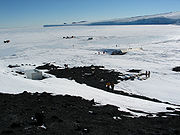
Cape Evans
Encyclopedia

Ross Island
Ross Island is an island formed by four volcanoes in the Ross Sea near the continent of Antarctica, off the coast of Victoria Land in McMurdo Sound.-Geography:...
, forming the north side of the entrance to Erebus Bay
Erebus Bay
Erebus Bay is a bay about 13 nautical miles wide between Cape Evans and Hut Point Peninsula, on the west side of Ross Island. The bay was explored by the Discovery expedition under Scott. It was named by Scott's second expedition, the British Antarctic Expedition , which built its headquarters...
.
The cape was discovered by the Discovery expedition
Discovery Expedition
The British National Antarctic Expedition, 1901–04, generally known as the Discovery Expedition, was the first official British exploration of the Antarctic regions since James Clark Ross's voyage sixty years earlier...
(1901–04) under Robert Falcon Scott
Robert Falcon Scott
Captain Robert Falcon Scott, CVO was a Royal Navy officer and explorer who led two expeditions to the Antarctic regions: the Discovery Expedition, 1901–04, and the ill-fated Terra Nova Expedition, 1910–13...
, who named it the Skuary. Scott's second expedition, the British Antarctic Expedition (1910–13), built its headquarters here, renaming the cape for Lieutenant Edward R.G.R. Evans, Royal Navy
Royal Navy
The Royal Navy is the naval warfare service branch of the British Armed Forces. Founded in the 16th century, it is the oldest service branch and is known as the Senior Service...
, second in command of the expedition. Scott's headquarters building still exists and is known as Scott's Hut
Scott's Hut
Scott's Hut is a building located on the north shore of Cape Evans on Ross Island in Antarctica. It was erected in 1911 by the British Antarctic Expedition of 1910–1913 led by Robert Falcon Scott...
.
See also
- Erebus Ice TongueErebus Ice TongueThe Erebus Ice Tongue is a mountain outlet glacier that projects 11–12 km into McMurdo Sound from the Ross Island coastline near Cape Evans, Antarctica. The glacier tongue varies in thickness from 50 m at the snout to 300 m at the point where it is grounded on the shoreline. Explorers from...
- McMurdo SoundMcMurdo SoundThe ice-clogged waters of Antarctica's McMurdo Sound extend about 55 km long and wide. The sound opens into the Ross Sea to the north. The Royal Society Range rises from sea level to 13,205 feet on the western shoreline. The nearby McMurdo Ice Shelf scribes McMurdo Sound's southern boundary...
- Mount ErebusMount ErebusMount Erebus in Antarctica is the southernmost historically active volcano on Earth, the second highest volcano in Antarctica , and the 6th highest ultra mountain on an island. With a summit elevation of , it is located on Ross Island, which is also home to three inactive volcanoes, notably Mount...
- Ross IslandRoss IslandRoss Island is an island formed by four volcanoes in the Ross Sea near the continent of Antarctica, off the coast of Victoria Land in McMurdo Sound.-Geography:...
- Robert Falcon ScottRobert Falcon ScottCaptain Robert Falcon Scott, CVO was a Royal Navy officer and explorer who led two expeditions to the Antarctic regions: the Discovery Expedition, 1901–04, and the ill-fated Terra Nova Expedition, 1910–13...
- Ernest ShackletonErnest ShackletonSir Ernest Henry Shackleton, CVO, OBE was a notable explorer from County Kildare, Ireland, who was one of the principal figures of the period known as the Heroic Age of Antarctic Exploration...
- Terra Nova ExpeditionTerra Nova ExpeditionThe Terra Nova Expedition , officially the British Antarctic Expedition 1910, was led by Robert Falcon Scott with the objective of being the first to reach the geographical South Pole. Scott and four companions attained the pole on 17 January 1912, to find that a Norwegian team led by Roald...

